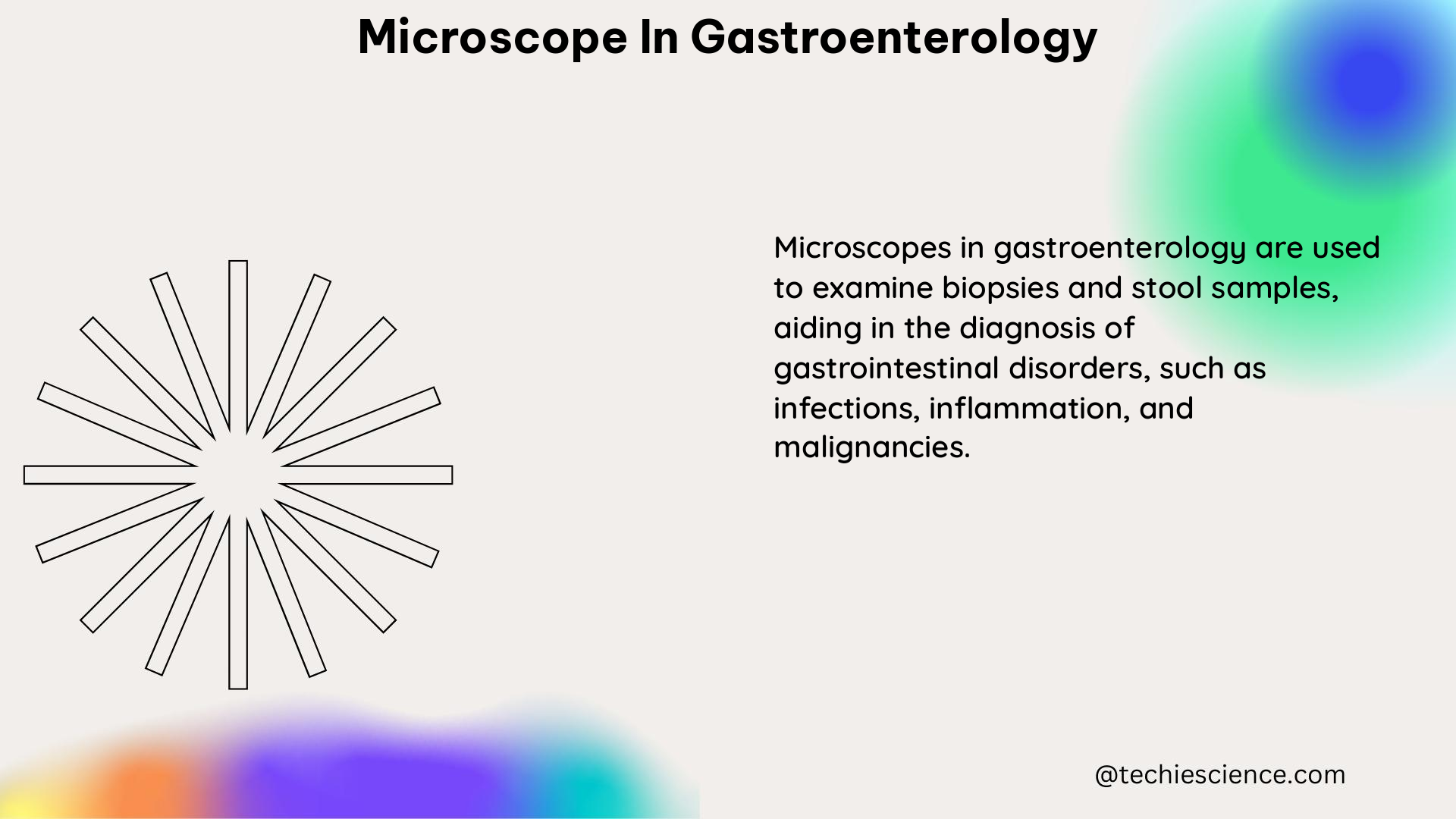Microscopes play a crucial role in the field of gastroenterology, enabling researchers and clinicians to study the complex structures and dynamics of the gastrointestinal tract. From hyperspectral/multispectral imaging to electron microscopy and live-cell confocal microscopy, these advanced imaging techniques provide valuable insights into the diagnosis, treatment, and understanding of gastrointestinal diseases.
Hyperspectral/Multispectral Imaging (HSI/MSI)
Hyperspectral and multispectral imaging are powerful tools in gastroenterology, offering a wide range of spectral information to analyze the composition and characteristics of gastrointestinal tissues. These imaging techniques utilize specialized cameras and light sources to capture detailed spectral data, which can be used for various applications.
Spectral Range
The spectral range of HSI/MSI in gastroenterology typically spans from 440 to 1830 nanometers (nm), covering a significant portion of the visible and near-infrared regions of the electromagnetic spectrum.
Spatial Resolution
The spatial dimensions of each hyperspectral cube can reach up to 1024 × 1024 pixels, with 20 spectral bands covering the wavelength range from 450 to 640 nm. This high spatial resolution allows for detailed analysis of the gastrointestinal tissue structure and composition.
Accuracy
Using support vector machine (SVM) classification, HSI/MSI has demonstrated an accuracy of 99.72% in discriminating between normal and malignant gastrointestinal tissues. This remarkable level of accuracy highlights the potential of these imaging techniques in early cancer detection and diagnosis.
Electron Microscopy

Electron microscopy offers a significantly higher resolution compared to light microscopy, enabling the study of subcellular structures within the gastrointestinal tract. This advanced imaging technique provides valuable insights into the ultrastructural details of cells and tissues.
Resolution
Electron microscopy can achieve a much higher resolution than light microscopy, allowing for the visualization and quantification of subcellular components, such as mitochondrial cristae morphology and mitochondrial contact sites.
Applications
One of the key applications of electron microscopy in gastroenterology is the quantification of mitochondrial ultrastructure. By analyzing the morphology and organization of mitochondria, researchers can gain a deeper understanding of cellular energy metabolism and its role in gastrointestinal diseases.
Light Microscopy
While light microscopy has limitations in resolving subcellular structures, it remains a valuable tool in gastroenterology, particularly for real-time imaging of live samples.
Resolution Limit
The resolution of light microscopy is inherently limited by the wavelength of visible light, which restricts its ability to visualize the finest details within gastrointestinal tissues.
Real-Time Imaging
Despite the lower resolution compared to electron microscopy, light microscopy enables the observation of live samples in real-time, providing insights into the dynamic processes occurring within the gastrointestinal tract.
Quantitative Analysis
Quantitative analysis of microscopic images in gastroenterology is crucial for extracting meaningful data and understanding the underlying biological processes. However, this process can be time-consuming and challenging, particularly when dealing with large data sets.
Image Processing
The image processing required for quantitative analysis can take several hours, and the resulting data may be limited, preventing real-time feedback on sample imaging. This highlights the need for efficient and automated image processing algorithms to streamline the analysis workflow.
Data Storage
The raw data generated from microscopic imaging in gastroenterology can be massive, with a single analysis potentially producing up to 0.62 terabytes of data. Effective data storage and management strategies are essential to handle these large data sets.
Imaging Software
Specialized imaging software plays a crucial role in the analysis and visualization of microscopic data in gastroenterology. These software solutions provide advanced tools for handling, processing, and interpreting the complex data generated by various imaging modalities.
Amira Software
Amira software is a powerful tool that supports innovation in gastroenterology by enabling the handling of large, multichannel, and time-series data. It provides advanced visualization, correlation, and processing capabilities, allowing researchers to extract meaningful insights from their microscopic data.
Xplore5D Extension
The Xplore5D extension is another valuable tool in the field of gastroenterology. It enhances the handling of large data sets and supports a wide range of imaging modalities, including light sheet fluorescence microscopy, electron microscopy, computed tomography (CT), magnetic resonance imaging (MRI), and positron emission tomography (PET).
Live-Cell Confocal Microscopy
Live-cell confocal microscopy is a powerful technique that enables the real-time observation and quantification of dynamic processes within the gastrointestinal tract.
Timing
The image acquisition process in live-cell confocal microscopy can take anywhere from 20 to 180 minutes, depending on the specific experimental setup and the complexity of the sample. Additionally, the image processing step can require up to 20 minutes to complete.
Quantification
Live-cell confocal microscopy allows for the direct measurement of invasive dynamics, including the formation of invadopodia (specialized cellular protrusions), cell membrane protrusions, and basement membrane (BM) removal. These quantitative measurements provide valuable insights into the mechanisms underlying gastrointestinal diseases.
By understanding the capabilities and limitations of these various microscopy techniques, researchers and clinicians in gastroenterology can leverage the most appropriate tools to address their specific research questions and clinical needs. The integration of advanced imaging software further enhances the analysis and interpretation of the complex data generated by these microscopic imaging modalities.
References
- Hyperspectral Imaging for Gastrointestinal Cancer Detection
- Quantitative Tissue Microscopy in Gastroenterology
- Microscopic Solutions for Big Data
- Image-Based Cell Profiling Enables Quantitative Tissue Microscopy in Gastroenterology
- Quantitative Tissue Microscopy in Gastroenterology

The lambdageeks.com Core SME Team is a group of experienced subject matter experts from diverse scientific and technical fields including Physics, Chemistry, Technology,Electronics & Electrical Engineering, Automotive, Mechanical Engineering. Our team collaborates to create high-quality, well-researched articles on a wide range of science and technology topics for the lambdageeks.com website.
All Our Senior SME are having more than 7 Years of experience in the respective fields . They are either Working Industry Professionals or assocaited With different Universities. Refer Our Authors Page to get to know About our Core SMEs.